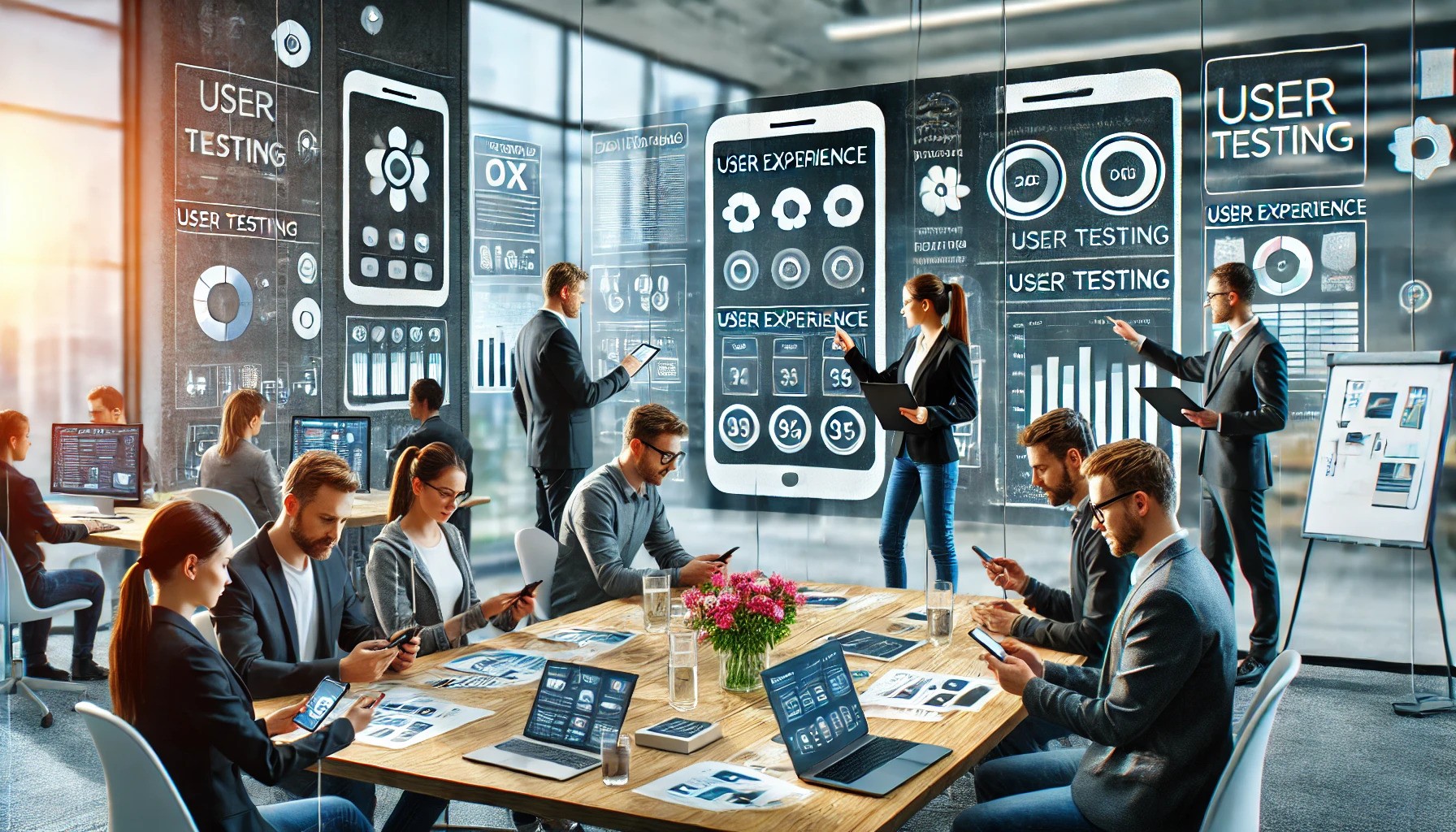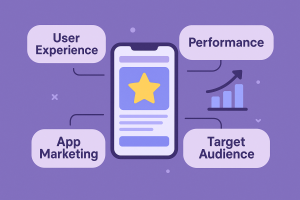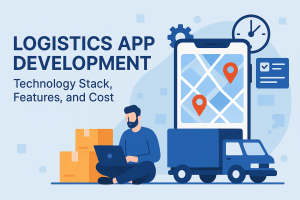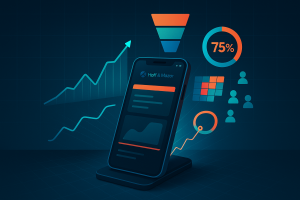Suppose you are an active mobile user and have recently downloaded a new shopping app. Though the app seems attractive, you encounter several functional and usability issues. For instance, you find navigation of the app complex and difficult. Unclear app navigation instructions, unintuitive interface design, unresponsive buttons, small text size, and unreadable fonts frustrate you and make you lose interest in app browsing. The other usability and performance issues of the app include frequent crashes, slow loading times, inaccurate data display, and other navigational glitches that make the app less engaging. Inadequate app development and app incompatibility show the negligence of mobile app development companies in usability testing and optimizing app performance before the final launch of the app in the market.
Google statistics relates that the evolution of mobile apps in the market has led to an increased number of mobile app users. Mobile app user flow across the globe is likely to reach 7.5 billion by 2026. However, different functional and performance errors such as continuous app crashes and functionality bugs caused 80% of customers to delete or uninstall an app. While 50% of customers either uninstall or abandon the app as they face navigation complications, loading delays, sideload apps on iOS, and other interruptions.
Significance of Usability Testing for Mobile Application
Before proceeding with mobile application development and execution, mobile app developers should consider mobile app usability testing to maximize app productivity and boost user engagement. Regular user testing involves identifying potential usability issues such as complex navigation, unappealing UI/UX design, unresponsive buttons, and fonts. Moreover, the testing experts also evaluate other functional errors such as slow loading times, monotonous content, lack of personalization, and unintuitive app features. The key benefit of performing usability tests is to let the app designers know about user behavior, their choices, and trends in selecting an appropriate mobile app. Detection of functional and usability errors during the development cycle also pinpoints areas of confusion and difficulty in the app navigation.
The knowledge of demography allows testers to take insights from consumer feedback, modify the app’s design, and add innovative features and functionality to create visually appealing UI/UX design and other components. Consequently, mobile app usability testing helps systems programmers guide users through a simple application navigation. The users get familiar with consistent navigation patterns such as tab bars or hamburger menus, and learn about different sections in the application.
The mobile usability testing process encompasses a constant cycle of analysis, designing and prototyping, coding, testing, and quality assurance. The iterative testing spots the key mobile app design mistakes and rectifies the errors in the development process. Data-driven mobile app testing monitors app performance optimization issues such as tracking memory consumption, network bandwidth, and page load time. Moreover, the usability test broadly evaluates the app’s functionality and verifies that all components within the mobile app are optimized and seamlessly operate on different devices.
Hence, the ultimate goal of usability testing is to develop high-performance, user-friendly apps that are aligned with the user’s needs, and perceptions and provide a smooth and convenient way to interact with the application.
Planning Your User Testing Process
Define the Purpose of Testing
The initial phase of usability testing begins with thorough planning. The project manager and development team engage in detailed planning and discussions regarding the purpose, and objectives of the app testing. Creating a roadmap for mobile app testing allows developers to know which category of app will undergo the testing procedure. Evaluation of app testing allows testing experts to determine an appropriate timeline to execute the usability testing. Moreover, the testing team deliberates over which tools and resources are required for conducting the app testing. The market research team surveyed competing apps in the market. Analyzing the competitor’s marketing strategy of creating real-world practical applications helps them know changing market trends, the target audience’s choices, behavior, and trends of choosing the preferred app genre. Based on their wide market research and consumer feedback, the testing team develops a plan that maximizes the app’s performance in the market and also identifies growth opportunities. Hence, setting specific and measurable testing goals and usability metrics helps developers devise an effective usability test plan.
Preparing for User Testing
Setting Tasks for Testing
To carry out appropriate usability testing, Expert android app developer for hire analyze their testing objectives. The next step follows meticulously picking up the task scenarios to conduct an accurate usability test. Before delving into the testing phase, the usability experts find suitable participants who conduct effective testing procedures. Each scenario is based on real-world scenarios. The test case reflects authentic situations that test participants encounter while interacting with the app. It includes their positive experiences with the app and potential pain points of the users. Usability experts set up test scenarios and organize the sequence of the testing procedure. While creating the task scenarios, the trainer separates each scenario into different actionable steps. They guide the participants with different strategies to work on the assigned tasks. A common procedure is to get registered and sign in to the account. The users upload media files to work on the task. Moreover, they have the accessibility to browse different sites and conduct thorough research to compile test reports along with their feedback regarding the type of application they worked on. The specific task test requires users to keep a recorded session of the tests along with screenshots of the data and results gathered.
Moreover, the testing experts examine the usability tools required by participants. Multiple testing tools such as User Testing, Lookback, UserZoom, and CI/CD tools are fixed in the testing venue. These tools comprising features, session recordings, click testing, and surveys help users to generate comprehensive test reports and gather real user feedback. The testing tools specialize in testing mobile apps that effectively capture user interaction and behavior with real devices. Moreover, the tools analyze recordings and other visual representations that further assist users in preparing a comprehensive report. The usability testing tools outline an authentic result for each scenario.
The mobile app developer also sets an evaluation criteria that helps them know the specific elements of the user experience during the usability test. The usability metrics include task beginning and completion duration, time-on-screen utilized by the user, how much time was consumed while executing the entire test procedure and measuring user satisfaction score. Once, the experts have defined the testing goals and criteria, they proceed toward the next phase of creating the test documentation.
Develop Test Documentation
Comprehensive usability testing allows app development companies to develop different documents to ensure authenticity and consistency in usability testing. The report covers testing objectives, test scenarios, bug reports, the methodology, and criteria of testing. Hence, validated test plans and records support the claim or facts in the testing and demonstrate the effectiveness of usability testing.
Recruiting Usability Testing Participants
Usability testing involves the observation of test participants to operate a mobile app. The individuals use their mobile devices to work on the specific task assigned. The facilitator recruits mobile users who have been using their devices for at least 3 months. The testing participants include Android or professional iOS app developers in USA who are prepared to sign the consent testing form and confirm their availability while undergoing all the stages of usability tests. The testing participants are entitled to maintain confidentiality after coming up with validated assumptions and preparing an accurate and precise testing report.
The usability test is conducted in a positive testing environment where participants fill out a questionnaire about the specific task they are assigned to work. During an initial interview, the instructor and contributors team engage in an interactive conversation about how to perform the usability test. The trainer briefs the team about sharing their experience and examines the positive and negative aspects of the app. If testing participants get confused at any stage of testing, they are guided by the facilitators on how to execute their usability testing. While performing the test participants express their thoughts, actions, and behaviors and come up with honest feedback based on their experience with the app.
During the testing phase, testers monitor users’ actions, verbal cues, and facial expressions to know their thought processes and responses related to the functionality of the app. Once the test users prepare their hypothesis including authentic results, the trainer converts raw data and user’s feedback into actionable insights. It helps usability experts identify the functional and usability issues and design and development errors in the app. Moreover, the usability specialists come to know the pain points of the users such as complex navigation, jumbled layouts, slow loading times, ambiguous instructions, and inconsistent design elements.
Based on valuable insights, they developed a comprehensive usability plan to improve the app’s core functions. Usability designers adopt a user-centered approach to create intuitive and appealing interface designs that make navigation simple and easy for the users. Furthermore, the visual aesthetics of the app boost user engagement with the app.
Mobile Application Usability Testing Methodology
Laboratory-based Usability Testing
Optimized usability testing allows iPhone app development to select an appropriate user testing category that resonates with users’ preferences, design choices, and existing and innovative trends in mobile apps. Laboratory testing allows usability experts to exert their complete control to set the tasks. An in-house-based testing test takes place under usability facilitators and requires a proper testing environment. Once, usability participants are selected and assigned specific tasks, the trainers fix essential testing tools in the usability testing lab. The test begins with filling out the consent form in the allotted five minutes. A Pre-test interview takes place that helps participants learn about usability test procedures. The testing users complete the test session within the scheduled time such as 35 to 40 minutes.
The lab is divided into two rooms that are separated by a one-way mirrored window. The lab includes a computer, fixed-position webcam, cradle-based camera, recording software, and adequate lighting that facilitates users with conducting authentic testing. The test observers are assisted by trainers who ensure that the test runs smoothly. The test participant fairly works on the assigned tasks and prepares a comprehensive research report based on gathering accurate data. The testing facilitator observes the test on their screen and proficiently captures the tester’s behavior, reactions, and expression as they carry out the test.
After the test execution, the testing facilitator conducts a post-questionnaire, post-test interview, and debriefing session. These testing sessions involve an interactive session between the trainer and the participants. The experts analyze the actions and behavior performed by the participant. Consequently, the testing appears to be productive as usability testers get additional insight into how to improve the functional and usability errors in the application before launching in the app market.
Remote Usability Tests
The other usability test includes remote usability tests. The criteria for conducting these tests signifies that the participant and the testing experts exist in different geographical areas and locations. Remote testing has now gained popularity as the best iOS app development services employ advanced technical tools to perform online usability testing. The digital testing is facilitated through the internet or by iPhone device. The sessions are normally carried out through a usability testing platform that comprises UX researchers/moderators who use fixed-position cameras, wireless testing, and recording tools to gather user data. Conversing with the participants, they observe and scrutinize the facial expressions, behavior, and actions of the users and instantly generate insights that help them overcome functional, design, and usability flaws.
Analyzing and Interpreting Test Results
Once the tests are concluded, the mobile app developer analyzes the data. They review the data and actionable insights from the participants. During the analysis process, the usability experts assess each test session and observe notes, transcripts, and other relevant materials provided by the users. Reviewing the background summary helps them analyze user behavior and interaction with the app. The specialists learn about the usability, functional issues, and other navigational challenges the users encounter during their interaction with the app.
The testing methodology comprising task scenarios identifies and determines the specific issues the participants encounter while interacting with Android or iPhone devices. The specific testing tasks also help testing experts learn issues related to user engagement, conversion metrics, and app performance metrics.
The test results include both quantitative and qualitative data and findings based on the users’ observations. The feedback form includes participants’ comments and observations and video recordings that pinpoint their pain points and expectations. Consequently, the attached recommendations and insights help in identifying areas for improvement and optimizing user experience metrics. It includes improving the session length and easy navigation that allows mobile users to complete key tasks without facing interruptions and bottlenecks. Improving page loading time and application speed for different devices and operating networks increases user engagement levels. Enhancing engagement and conversion metrics helps mobile app development companies evaluate the number of users who operate the app daily. They effectively measure the retention rate and the measure the percentage of visitors who leave the app without completing the desired task or purchasing.
The usability testing results help developers optimize the overall app experience by improving key metrics such as increasing task success rate and evaluating the frequency of errors made by users during task completion. Boost user engagement, and conversion rates, reduce crash rates, and upsurge user flow within the app. Post-task metrics provide insights into user perceptions and skills. It highlights what aspects the users enjoy while interacting with their mobile apps. Consequently, well-performing apps attract millions of users and influence them to become active app users.
Implementing Changes and Iterating in Usability Testing
Usability testing allows Android app development services with an ongoing process that demonstrates that the app is tested on users repeatedly. The marketing campaigns allow app marketers to collect user data in real time. Reviewing targeted market feedback and competitors’ strategies helps app development agencies to remain agile and adaptable. They modify their usability testing plans integrate innovative methods of testing to improve design, and integrate innovative features and components to improve the app’s visibility and reach. Based on consumer feedback and changing marketing trends, they look for new marketing approaches that improve user engagement and boost conversion rates and click-through rates.
Moreover, the marketers employ social media, search engines, and the App Store to improve social media engagement, and app rankings and enhance app discoverability among a broad audience. As the quality of the app improves, the usability testers re-evaluate their usability testing goals based on changing users’ perceptions, and choices, and fluctuating market conditions. Iterative updates, innovative features, and strong visuals offer a user-friendly app browsing experience to prospective clients. An effective usability test along with well-structured application tools simplifies the app development process and upsurges the app’s output in the market. Thus, a clear market value proposition keeps the app relevant stands out among the crowd, and helps generate high profit and (ROI.
Recapitulate
Whether you are an individual mobile app developer or operating a mobile app development company your top priority is to develop high-performance, intuitive, and scalable apps that resonate with user’s choices and perceptions. To validate the core functionalities of the app including analyzing wireframing and designs and essential app components suggest app testing experts perform usability tests. A systematic evaluation procedure addresses functional, usability, and performance issues in the app such as unclear layouts, monotonous interface, small buttons, unreadable fonts, and slow loading times. Robust testing identifies the missing elements, allowing the testing team to evaluate the amount of rework needed to improve the app’s usability. The testing team fixes these loopholes and makes efforts to launch high-performing and responsive apps that offer an engaging navigation experience to the users.
To initiate an effective usability test, developers state testing objectives and purposes that set a roadmap for the development team to conduct the test. They develop essential testing documentation comprising development and testing goals and objectives, test scenarios, and testing methodologies. Lab testing is conducted in a controlled environment. The users perform usability testing on their mobile devices to gather real-time data. Remote usability testing takes place when the participant and the researcher are in separate locations. They interact through the internet or online testing software. Delving into usability testing allows mobile developers to analyze user’s behavior and choices as they interact with the app. It also indicates the challenges they face while interacting with the app. An effective usability test with iterative goals and purposes improves users’ experience and efficiently rectifies functional and usability issues. Multiple usability tests have streamlined the testing process that optimizes your app’s performance and improves user acquisition, engagement, and conversion metrics.







